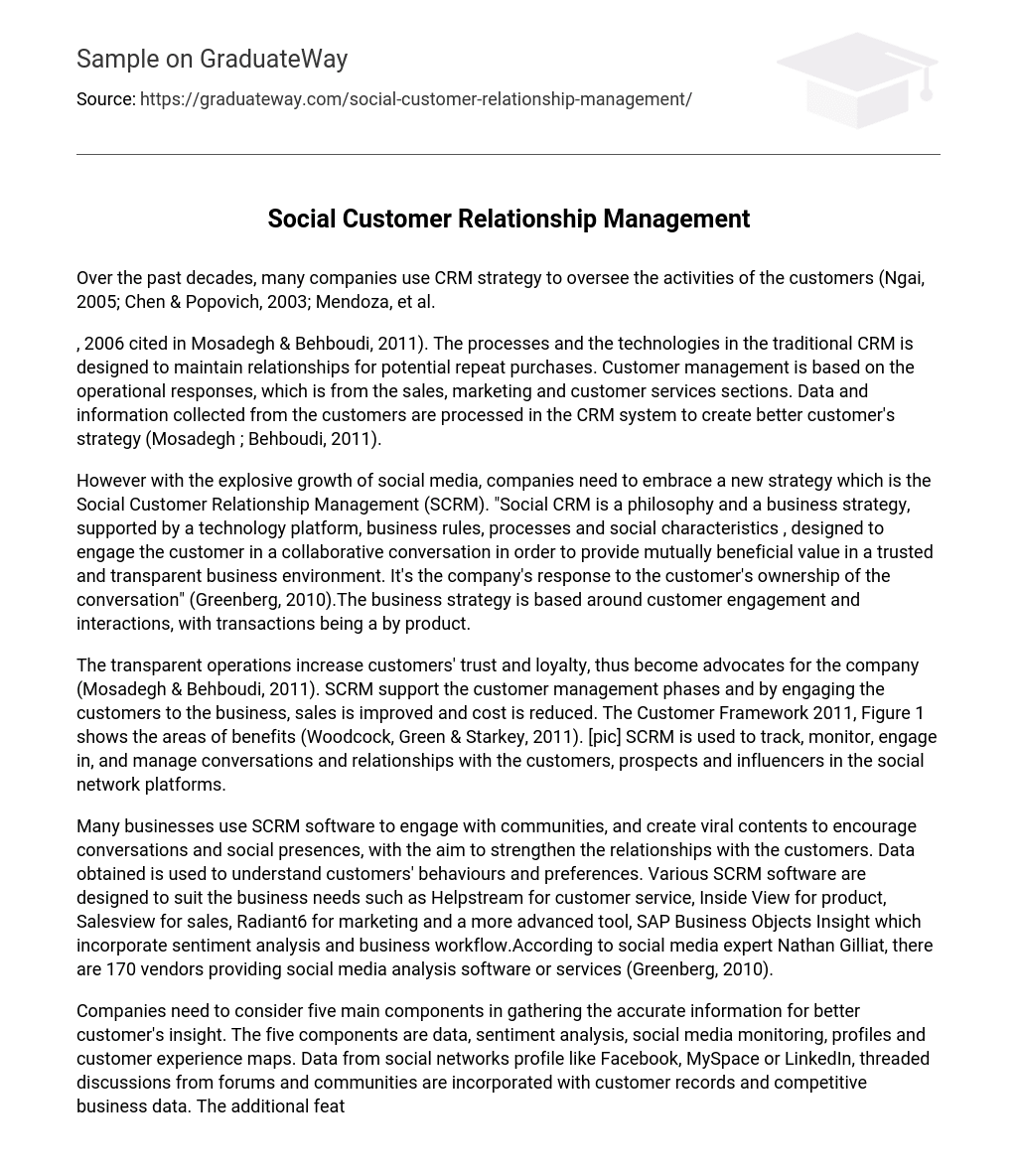Over the past decades, many companies use CRM strategy to oversee the activities of the customers (Ngai, 2005; Chen & Popovich, 2003; Mendoza, et al. , 2006 cited in Mosadegh & Behboudi, 2011). The processes and the technologies in the traditional CRM is designed to maintain relationships for potential repeat purchases. Customer management is based on the operational responses, which is from the sales, marketing and customer services sections. Data and information collected from the customers are processed in the CRM system to create better customer’s strategy (Mosadegh ; Behboudi, 2011).
However with the explosive growth of social media, companies need to embrace a new strategy which is the Social Customer Relationship Management (SCRM). “Social CRM is a philosophy and a business strategy, supported by a technology platform, business rules, processes and social characteristics , designed to engage the customer in a collaborative conversation in order to provide mutually beneficial value in a trusted and transparent business environment. It’s the company’s response to the customer’s ownership of the conversation” (Greenberg, 2010).The business strategy is based around customer engagement and interactions, with transactions being a by product.
The transparent operations increase customers’ trust and loyalty, thus become advocates for the company (Mosadegh & Behboudi, 2011). SCRM support the customer management phases and by engaging the customers to the business, sales is improved and cost is reduced. The Customer Framework 2011, Figure 1 shows the areas of benefits (Woodcock, Green & Starkey, 2011). [pic] SCRM is used to track, monitor, engage in, and manage conversations and relationships with the customers, prospects and influencers in the social network platforms.
Many businesses use SCRM software to engage with communities, and create viral contents to encourage conversations and social presences, with the aim to strengthen the relationships with the customers. Data obtained is used to understand customers’ behaviours and preferences. Various SCRM software are designed to suit the business needs such as Helpstream for customer service, Inside View for product, Salesview for sales, Radiant6 for marketing and a more advanced tool, SAP Business Objects Insight which incorporate sentiment analysis and business workflow.According to social media expert Nathan Gilliat, there are 170 vendors providing social media analysis software or services (Greenberg, 2010).
Companies need to consider five main components in gathering the accurate information for better customer’s insight. The five components are data, sentiment analysis, social media monitoring, profiles and customer experience maps. Data from social networks profile like Facebook, MySpace or LinkedIn, threaded discussions from forums and communities are incorporated with customer records and competitive business data. The additional features provide extra information to the businesses.
Sentiment analysis which aims to determine the attitude of an individual or group with respect to a topic also helps businesses to gain a better insight of the customers. The SAP’s Twitter analysis tool is an example, in which it measures the positivity or negativity discussions in Twitter that relates to a brand or company. Social media monitoring tool explore data through the listening of conversations on the web. An example is Radian6 , in which it monitors the blogs, social networking sites, forums, multimedia sharing sites, microblog.
Customer’s profile or personal information is essential to gain a deeper insight of the customers.From that, businesses can tailor products and services to suit the preferences of individuals. Customer experience mapping is also essential as it shows the consumer’s assessment from the beginning, middle and end as they engage to a service (Greenberg, 2009; 2010). The transition from CRM to SCRM strategy is a challenge for most businesses.
The major challenge for business is creating ROI goals, whereby the feasibility of social media adoption is evaluated. Businesses are also wary that employees use social media in an irresponsible manner and the brand is not represented appropriately.The consumers controlling the conversation in social media also place a threat to businesses. The negative conversation may lead to pessimistic brand exposure.
Other challenges faced are associated with human resources, privacy, government and industry regulations (Baird ; Parasnis, 2011). As much as the technologies and the right tool is in use, companies need to strategize their internal integrations in support of the implementation. A few methods are recommended to help companies in the transition of SCRM approach. The marketing and customer care plans need to be paralleled for a more holistic customer approach.
The implementation of Center of Execellence for SCRM is another approach whereby a team of people promote collaboration and use best customer engagement practices to drive business results. The employees involvement is essential and therefore, the building of virtual communities is recommended to connect the employees. Training is essential to equip employees with the necessary skills and Incentive programs encourage employees to value customers (Baird ; Parasnis, 2011). In conclusion, the co-operation of social media tools and approaches with traditional CRM platform can promote a strong customer-centric business relationships.
Also, by creating sales social network, the productivity of the sales force is increased. Social CRM may not replace traditional CRM, but the evolution is foreseeable. The key to success in engaging the customers to the business is to understand customer’s behaviour through information gathering, communication and engagement in conversations. Internal integration and managing of employees is significant to ensure the exploitation of this new business strategy.
A business that can adopt the SCRM strategies will gain a competitive edge especially in this technology based business world.





